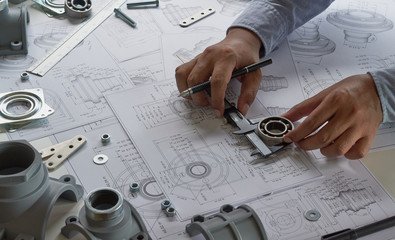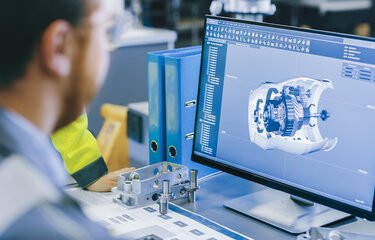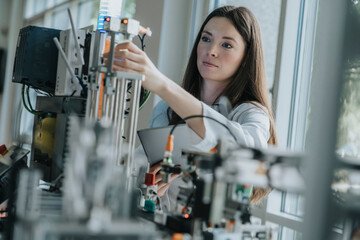Engineers are problem solvers. Successful engi- neers possess good communication skills and are team players. They have a good grasp of fundamental physical laws and mathemat- ics. Engineers apply physical and chemical laws and math- ematics to design, develop, test, and supervise the manu- facture of millions of products and services. They consider important factors such as sustainability, efficiency, cost, reliability, and safety when designing products. Engineers are dedicated to lifelong learn-ing and service to others.

Possibly some of you are not yet certain you want to study engineering during the next four years in college and may have questions similar to the following:
Do I really want to study engineering?
What is engineering and what do engineers do?
What are some of the areas of specialization in engineering? How many different engineering disciplines are there?
Do I want to become a mechanical engineer, or should I pursue civil engineering? Or would I be happier becoming an electrical engineer?
How will I know that I have picked the best field for me?
Will the demand for my area of specialization be high when I graduate, and beyond that?
The main objectives of this chapter are to provide some answers to these and other questions you may have, and to introduce you to the engineering profession and its various branches.

Engineers make products and provide services that make our lives better (see Figure 1.1). To see how engineers contribute to the comfort and the betterment of our everyday lives, tomor- row morning when you get up, just look around you more carefully. During the night, your bedroom was kept at the right temperature thanks to some mechanical engineers who designed the heating, air-conditioning, and ventilating systems in your home. When you get up in the morning and turn on the lights, be assured that thousands of mechanical and electrical engineers and technicians at power plants and power stations around the country are making certain the flow of electricity remains uninterrupted so that you have enough power to turn the lights on or turn on your TV to watch the morning news and weather report for the day. The TV you
are using to get your morning news was designed by electrical and electronic engineers. There are, of course, engineers from other disciplines involved in creating the final product; for example, manufacturing and industrial engineers. When you are getting ready to take your morning shower, the clean water you are about to use is coming to your home thanks to civil and mechanical engineers. Even if you live out in the country on a farm, the pump you use to bring water from the well to your home was designed by mechanical and civil engineers. The water could be heated by natural gas that is brought to your home thanks to the work and effort of chemical, mechanical, civil, and petroleum engineers. After your morning shower, when you get ready to dry yourself with a towel, think about what types of engineer worked behind the scenes to produce the towels. Yes, the cotton towel was made with the help of agricultural, industrial, manufacturing, chemical, petroleum, civil, and mechanical engineers. Think about the machines that were used to pick the cotton, transport the cotton to a factory, clean it, and dye it to a pretty color that is pleasing to your eyes. Then other machines were used to weave the fabric and send it to sewing machines that were designed by mechanical engineers. The same is true of the clothing you are about to wear. Your clothing may contain some polyester, which was made possible with the aid of petroleum and chemical engineers. “Well,” you may say, “I can at least sit down and eat my breakfast and not wonder whether some engineers made this possible as well.” But the food you are about to eat was made with the help and collabora- tion of various engineering disciplines, from agricultural to mechanical. Let’s say you are about to have some cereal. The milk was kept fresh in your refrigerator thanks to the efforts and work of mechanical engineers who designed the refrigerator components and chemical engineers who investigated alternative refrigerant fluids with appropriate thermal properties and other envi- ronmentally friendly properties that can be used in your refrigerator. Furthermore, electrical engineers designed the control and the electrical power units.

Now you are ready to get into your car or take the bus to go to school. The car you are about to drive was made possible with the help and collaboration of automotive, mechanical, electri- cal, electronic, industrial, material, chemical, and petroleum engineers. So, you see there is not much that you do in your daily life that has not involved the work of engineers. Be proud of the decision you have made to become an engineer. Soon you will become one of those whose behind-the-scenes efforts will be taken for granted by billions of people around the world. But you will accept that fact gladly, knowing that what you do will make people’s lives better.
Engineers Deal with an Increasing World Population and Sustainability Concerns
We as people, regardless of where we live, need the following things: food, clothing, shelter, and water for drinking or cleaning purposes. In addition, we need various modes of transportation to get to different places, because we may live and work in different cities or wish to visit friends and relatives who may live elsewhere. We also like to have some sense of security, to be able to relax and be entertained. We need to be liked and appreciated by our friends and family, as well. Increasingly, because of worldwide socioeconomic population trends, environmental concerns, and the earth’s finite resources, more is expected of engineers. Future engineers are expected to provide goods and services that increase the standard of living and advance health care while also addressing serious environmental and sustainability concerns. At the turn of the 20th century, there were approximately six billion of us inhabiting the earth. As a means of comparison, it is important to note that the world population 110 years ago, at the turn of the
19th century, was one billion. Think about it. It took us since the beginning of human existence to reach a population of one billion. It only took 110 years to increase the population by fivefold. Some of us have a good standard of living, but some of us living in developing countries do not. You will probably agree that our world would be a better place if every one of us had enough to eat, a comfortable and safe place to live, meaningful work to do, and some time for relaxation. According to the latest estimates and projections of the U.S. Census Bureau, the world population will reach 9.3 billion people by the year 2050. Not only will the number of people inhabiting the earth continue to rise but the age structure of the world population will also change. The world’s elderly population — the people at least 65 years of age —will more than
double in the next 25 years (see Figure 1.2).
How is this information relevant? Well, now that you have decided to study to become an engineer, you need to realize that what you do in a few years after your graduation is very
figure1.2important to all of us. The world’s current economic development is not sustianable — the world population already uses approximately 20% more of the world’s resources than the planet can sustain. (United Nations Millenium Ecosystem Assessement Synthesis Report, 2005.) You will design products and provide services especially suited to the needs and demands of an increasing eld- erly population as well as increased numbers of people of all ages. So prepare well to become a good engineer and be proud that you have chosen the engineering profession in order to con- tribute to raising the living standard for everyone and at the same time addressing environ- mental and sustainability concerns. Today’s world economy is very dynamic. Corporations continually employ new technologies to maximize efficiency and profits. Because of this ongo- ing change and emerging technologies, new jobs are created and others are eliminated. Com- puters and smart electronic devices are continuously reshaping our way of life. Such devices influence the way we do things and help us provide the necessities of our lives — clean water, food, and shelter. You need to become a lifelong learner so that you can make informed deci- sions and anticipate as well as react to the global changes caused by technological innovations as well as population and environmental changes. According to the Bureau of Labor Statistics,
U.S. Department of Labor, among the fastest-growing occupations are engineers, computer spe- cialists, and systems analysts.




